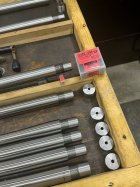Nobody has mentioned measuring the threads yet. I know a lot of people despise the 3 wire method and I've heard 2 dozen hacks on how to do it easier. This is how I do it.
Set the mic .005 over your expected measurement.
Put 2 wires on top, holding the third in your mouth.
Hold the top 2 in place with the mic's spindle.
Place the third one in the thread occupied by the LH wire and trace it down until it slides in place over the anvil.
If you set your mic close enough, the wires are now trapped and can't fall out while your hands are free to take your measurement.
Set the mic .005 over your expected measurement.
Put 2 wires on top, holding the third in your mouth.
Hold the top 2 in place with the mic's spindle.
Place the third one in the thread occupied by the LH wire and trace it down until it slides in place over the anvil.
If you set your mic close enough, the wires are now trapped and can't fall out while your hands are free to take your measurement.
















